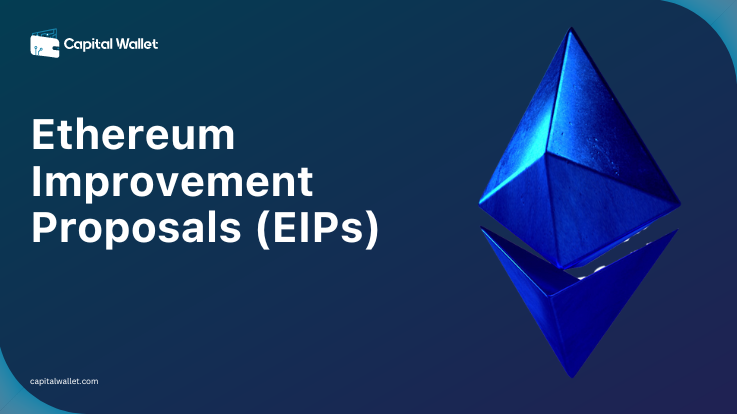
Introduction to Ethereum Improvement Proposals (EIPs)
EIPs refer to Ethereum Improvement Proposals. They are basically formal documents that propose changes or improvements to the Ethereum blockchain network. They function like blueprints outlining potential upgrades or new features for the Ethereum blockchain. More Specifically:
Purpose:
EIPs serve as a mechanism for the Ethereum community to propose, discuss, and implement changes to the network.
Who can propose:
Anyone within the Ethereum community, including developers and regular users, can submit an EIP.
Content:
EIPs detail the technical specifications of the suggested changes, along with the reasoning behind them.
Impact:
EIPs play a vital role in Ethereum’s evolution by fostering a collaborative decision-making process for improvements.
A Brief History of EIPs
Imagine Ethereum as a constantly evolving software program. Just like any software, improvements and updates are crucial for its growth. EIPs were introduced in 2015 as a formal way for the Ethereum community to propose these changes. Ethereum Improvement Proposals (EIPs) allow anyone with an idea to submit it, sparking discussions and debates that ultimately shape the future of Ethereum.
Why Do EIPs Matter
EIPs play a critical role in the decentralized decision-making process of Ethereum. Think of Ethereum Improvement Proposals (EIPs) as the voice of the Ethereum community. They offer a platform for proposing innovative features, addressing potential problems, and ultimately, ensuring Ethereum stays at the forefront of blockchain technology. Through EIPs, the community can collectively decide how Ethereum functions, evolves, and adapts to the ever-changing technological landscape. They ensure that changes are transparent, well-documented, and accessible to the entire community.
Types of Ethereum Improvement Proposals (EIPs)
A.Standard Track EIPs:
These are the most important type of EIP and propose changes that directly affect how Ethereum works. They are further divided into subcategories like:
Core:
Modifications to the core Ethereum protocol, like block validation or consensus mechanisms (e.g., EIP-1559 for fee changes).
Networking:
Improvements to how Ethereum nodes communicate with each other on the network.
Interface:
How users and applications interact with the Ethereum blockchain (e.g., EIPs defining wallet formats).
ERC (Ethereum Request for Comment):
Standards for applications built on top of Ethereum, like the ERC-20 token standard for fungible tokens or ERC-721 for non-fungible tokens (NFTs).
B. Meta EIPs:
These EIPs focus on processes surrounding Ethereum development, rather than code changes. They might propose new guidelines for developers or alterations to development tools. While they don’t change the code itself, they still require community consensus.
C. Informational EIPs:
These are informational documents that provide details about a design concept or idea related to Ethereum. They don’t propose specific changes and don’t require consensus.
Difference Between ERCs and EIPs
EIPs are all-encompassing proposals for improvements, while ERCs (Ethereum Request for Comments) are a specific type of EIP that focuses on establishing token standards. For instance, the widely used ERC-20 token standard, which underpins most Ethereum-based tokens, was originally proposed through an EIP.
The EIP Process
The EIP process is all about open discussion and collaboration. Here’s a simplified breakdown:
EIP Proposal:
A proposal is drafted and submitted for review. The beauty of EIPs lies in their accessibility. Developers, enthusiasts, or even newcomers can propose ideas through Ethereum Improvement Proposals (EIPs).
Community Discussion:
The Ethereum community, including developers and stakeholders, discuss and refine the proposal. This is where the real magic happens – experts analyze the proposal’s feasibility, potential impact, and overall benefits for the network.
Formal Review:
The EIP is reviewed for technical soundness and alignment with Ethereum’s vision through online forums, discussions, and voting. This ensures that changes made to Ethereum reflect the collective will of its users.
Implementation:
Once accepted, the EIP is implemented in the Ethereum codebase, ultimately shaping how the network functions.
The Impact of EIPs
Ethereum Improvement Proposals (EIPs) have played a pivotal role in shaping Ethereum’s journey.
For instance, EIP-20, the standard interface for Ethereum tokens, known as ERC-20, revolutionized how tokens are created and exchanged on the Ethereum network. Moreover, EIP-1559, a major upgrade implemented in 2021, introduced a mechanism for burning transaction fees, making Ethereum more sustainable and deflationary. Looking ahead, several exciting EIPs are in the pipeline, aiming to improve scalability, security, and overall user experience for the Ethereum network.
Conclusion
By understanding Ethereum Improvement Proposals (EIPs), you gain a deeper appreciation for the collaborative spirit that drives Ethereum’s evolution. It’s a testament to the power of a passionate community working together to build a better, more innovative blockchain platform.
Frequently Asked Questions (FAQs)
1. What are Ethereum Improvement Proposals (EIPs) and how are they different from ERCs?
They are formal documents that propose changes or improvements to the Ethereum blockchain network.
2. Who can submit an EIP?
Anyone can submit an EIP. The Ethereum community encourages participation from developers, enthusiasts, and even newcomers with ideas for improvement.
3. How does the EIP process work?
The EIP process is all about open discussion and collaboration. Here’s a simplified breakdown:
Anyone submits an EIP.
The community reviews and discusses the EIP.
Through online forums, discussions, and voting, the community decides whether to implement the EIP.
If there’s enough support, the EIP is coded into the Ethereum network.
4. Why are EIPs important?
EIPs are the building blocks for change and progress within the Ethereum network. They allow the community to propose new features, address potential problems, and ensure Ethereum stays innovative. By implementing EIPs, the community collectively decides how Ethereum functions and adapts to the ever-changing technological landscape.

